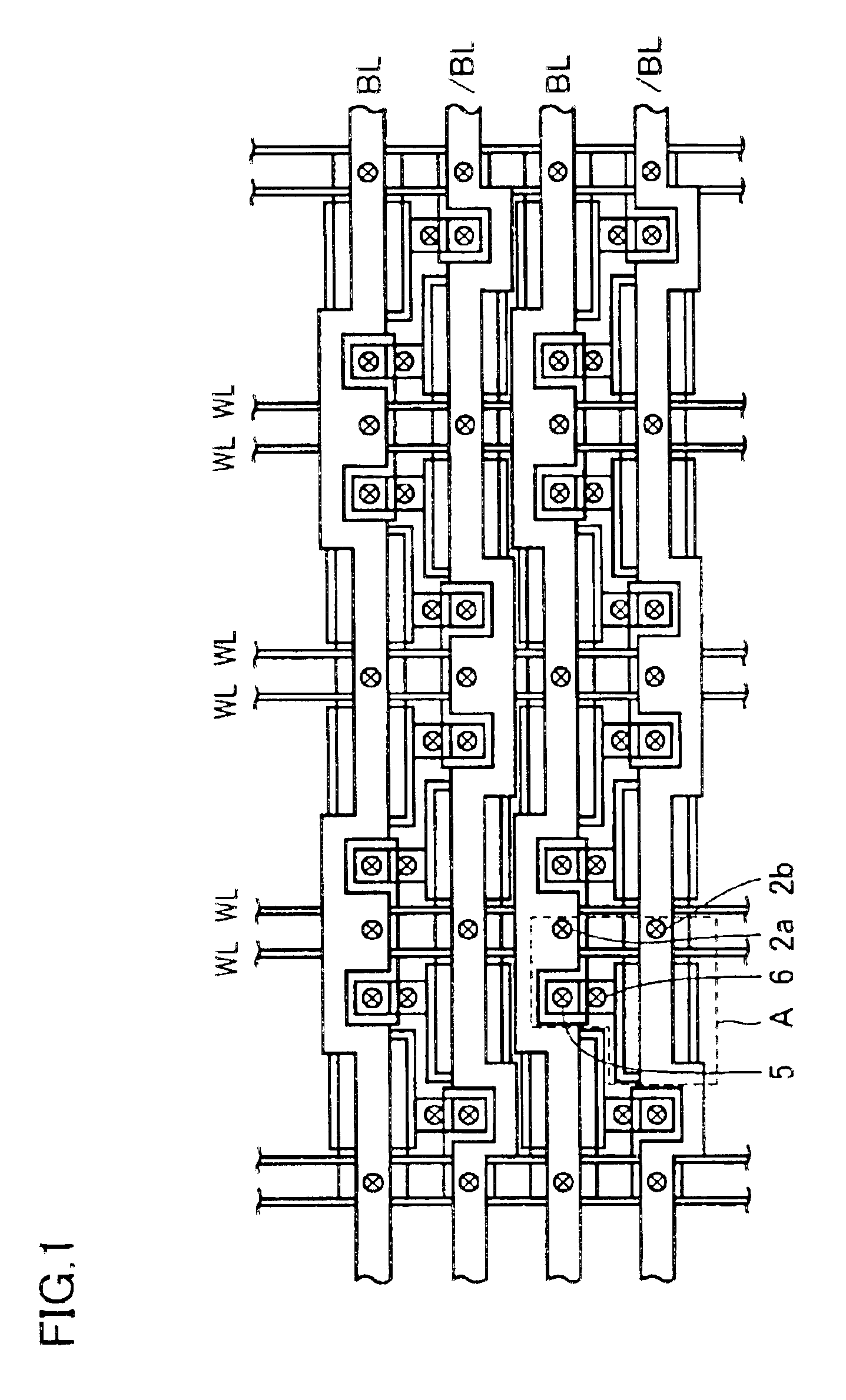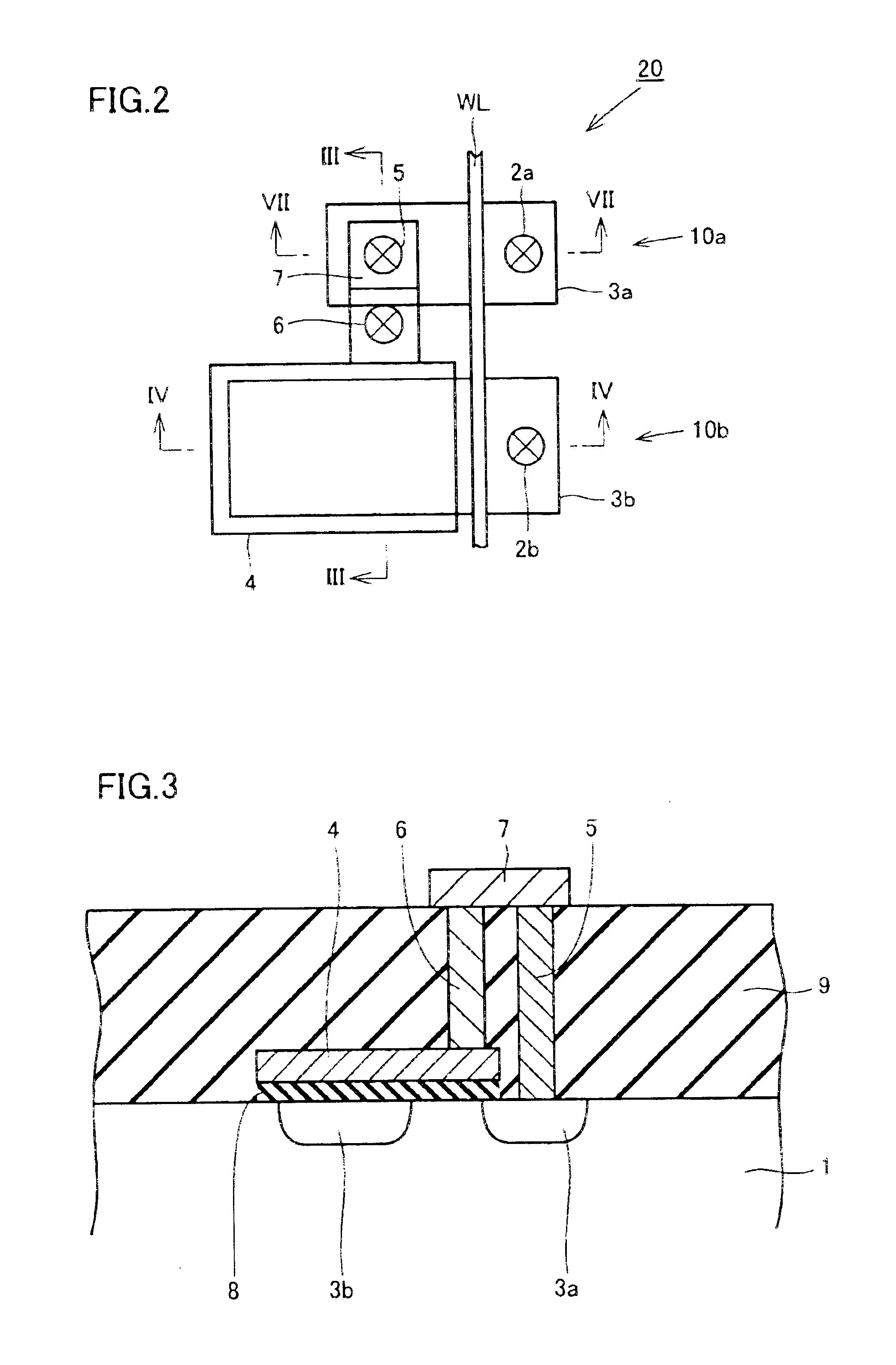Semiconductor memory device
a memory device and semiconductor technology, applied in semiconductor devices, digital storage, instruments, etc., can solve the problems of large area of memory cells, liable to loose information of memory cells of one-transistor and one-capacitor structures, etc., and achieve high data holding stability
- Summary
- Abstract
- Description
- Claims
- Application Information
AI Technical Summary
Benefits of technology
Problems solved by technology
Method used
Image
Examples
first embodiment
FIG. 1 shows an arrangement in a DRAM of a first embodiment of the invention. In FIG. 1, a memory cell in the DRAM is formed of two transistors and one capacitor. This DRAM can be achieved by repeating an arrangement of a portion, which is the memory cell including the two transistors and the one capacitor, and is indicated by “A”, by parallel translation, mirror-image mapping or point-symmetrical mapping. In FIG. 1, bit line contacts 2a and 2b are located under bit lines BL and / BL, respectively. Plug interconnections 5 and 6 form contacts for connecting the two transistors to an electrode of the capacitor.
FIG. 2 shows, on an enlarged scale, the portion indicated by “A” in FIG. 1. In this portion, two MOS transistors 10a and 10b are arranged along a word line WL serving also as gate electrodes. MOS transistors 10a and 10b have impurity regions 3a and 3b, respectively. The capacitor which is commonly used by the two transistors is formed between a cell plate 4 and impurity region 3b ...
second embodiment
A memory cell of a second embodiment of the invention differs from that of the first embodiment in that both the two transistors are connected only to the storage node side, and neither of them is connected to the cell plate.
In FIG. 14, the memory cells of the two-transistor and one-capacitor type of the invention are arranged to form a storage device of the background refresh type. In the semiconductor memory device of the background refresh type, one of the two transistors forming the memory cell is utilized as the access transistor, and the other is utilized as the transistor for refresh. In the array arrangement shown in FIG. 14, the memory cells of the two-transistor and one-capacitor type are present in a portion indicated by “C”, and this portion C is shown, on an enlarged scale, in FIG. 15. FIG. 16 is a cross section taken along line XVI—XVI in FIG. 15.
In FIG. 16, one transistor 10a has impurity region 3a connected to an access bit line ABL via bit line contact 2a as well as...
third embodiment
FIG. 21 shows a connection structure of sense amplifiers in a DRAM of the complementary capacity type of a third embodiment of the invention. The memory cell is of the two-transistor and one-capacitor type, and is the same as that of the second embodiment. However, the DRAM of this embodiment is of the complementary capacity type. Therefore, the two memory cells of the two-transistor and one-capacitor type in the second embodiment are coupled together to form one memory cell pair of this embodiment. Further, one of the transistors is used for the normal access, and the other is used for the refresh. This structure is the same as that in the arrangement of the second embodiment.
In the DRAM of the complementary capacity type described above, two memory cells are used for writing H-data and L-data, respectively. For this, the sense amplifiers and the bit lines are connected in such a manner that one access sense amplifier is connected to two access bit lines or two complementary access...
PUM
 Login to View More
Login to View More Abstract
Description
Claims
Application Information
 Login to View More
Login to View More - R&D
- Intellectual Property
- Life Sciences
- Materials
- Tech Scout
- Unparalleled Data Quality
- Higher Quality Content
- 60% Fewer Hallucinations
Browse by: Latest US Patents, China's latest patents, Technical Efficacy Thesaurus, Application Domain, Technology Topic, Popular Technical Reports.
© 2025 PatSnap. All rights reserved.Legal|Privacy policy|Modern Slavery Act Transparency Statement|Sitemap|About US| Contact US: help@patsnap.com



